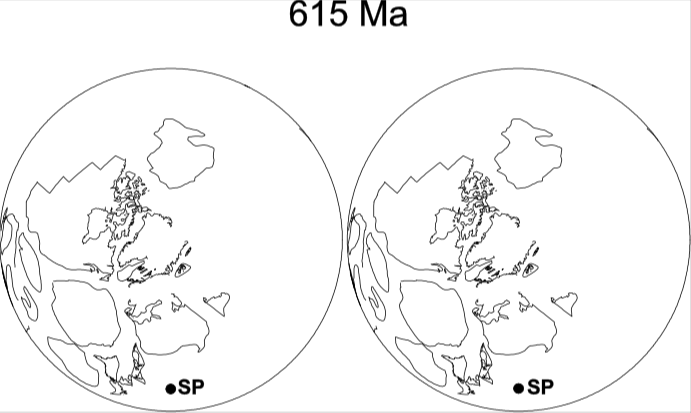The Vendian – Early Cambrian palaeomagnetic results from Laurentia suggest a complicated palaeogeographic pattern. On one hand, there is a group of three reliable poles (Callander, Catoctin A and Sept Iles B) indicating a similar high-latitude position of Laurentia at 580 – 560 Ma. These poles do not resemble any younger poles, so later remagnetization is unlikely. On the other hand, at least two other palaeomagnetic results for the same time span (Sept Iles A and Catoctin B) are equally, if not more likely to be primary and these require a low latitude position for Laurentia. From our point of view, the baked contact test in Sept Iles intrusion is the most rigorous and hence this data is the most reliable in constraining the position (low-latitude) of Laurentia. Also the Sept Isles results of Tanczyk et al. (1987) are confirmed by an independent study of Kirschvink et al. (2003). However, these poles overlap with the group of slightly younger Cambrian and some Ordovician poles. The same is true for the Long Range (615 Ma) pole. One possible explanation for the data set is a loop in the Apparent Polar Wander Path over this time period, similar to the Grenville loop for the end Mesoproterozoic (Pisarevsky et al., 2003 and references therein). However, the time and latitudinal succession of the different poles from high latitude (Callander) to low-latitude (Sept Isles A) then possibly back to high-latitude (Sept Isles B) before returning to low-latitude (Skinner Cove) cannot be explained by a single Apparent Polar Wander Path loop.
If all the Vendian – Early Cambrian palaeomagnetic results from Laurentia are primary and their ages are correctly assigned, then they cannot be explained by normal plate tectonics processes. The simplest explanation is that some of these data are not relevant, being either the result of remagnetization or incorrect deciphering of the palaeomagnetic signal (e.g. Meert and Van der Voo, 2001; Hodych et al., 2004). However, recently McCausland et al. (2003) reported the preliminary results from two other Quebec intrusions – Mont Rigaud stock, dated by U-Pb zircon at 563±14 Ma (Malka et al., 1996) and the Mutton Bay complex, which has given a K-Ar age of 578 Ma (Doig and Barton, 1968). These results indicate the near-polar position for Laurentia during the emplacement of the Mutton Bay complex, but low-to-equatorial palaeolatitudes during the intrusion of the Mont Rigaud stock.
True Polar Wander (e.g., Kirschvink et al., 1997; Kirschvink et al., 2003) could explain the apparent discrepancy between high and low-latitude Laurentian poles. It is also possible that late Neoproterozoic to early Cambrian time was characterized by an anomalously large non-dipole component of the Earth’s magnetic field (e.g., McCausland et al., 2003). In any case, we conclude that at present late Neoproterozoic and Early Cambrian palaeomagnetic data from Baltica and Laurentia are not self-sufficient for the creation of a reliable plate tectonic reconstruction and a unique model for Iapetus opening. The only pair of the coeval palaeopoles from both continents is the 616 Ma Egersund dykes pole (Storetvedt, 1966; Poorter, 1972a) and 615 Ma Long Range dykes pole (Murthy et al., 1992). This pair, shown in (Figure 1), clearly shows that only the reconstruction involving the juxtaposition of the western Scandinavian component of Baltica against the Rockall-Scotland-SE Greenland segment of Laurentia is valid at this time. Based on this Laurentia-Baltica configuration we created two computer animations (Figure 2) for the time interval between 615 and 540 Ma in 5 m.y. step intervals with alternate high-latitude and low latitude positions for Laurentia at ~ 580-560 Ma. Following the recommendation of Winchester (1988), we included a palinspastic reconstructions of northwestern Scandinavia and eastern Greenland that removes several hundreds kilometres of Caledonian shortening in both cases. Similar margin restorations have been used by a number of authors including Soper et al. (1992), Park et al. (1994), Fairchild and Hambrey (1995) and Higgins et al. (2001). Such palinspastic restorations are necessary to avoid strong overlap of the continental blocks during the spherical rotations. The approximate position of the pre-Caledonian continental boundaries were calculated in accordance with the studies of Andreasson (1994) for Scandinavia, and of Higgins and Leslie (2000) for East Greenland.
Figure 2. Palaeogeographic animations

Two sets of palaeogeographic animations for the high-latitude (left) and low-latitude (right) models between 615 and 540 Ma. SP – South Pole.